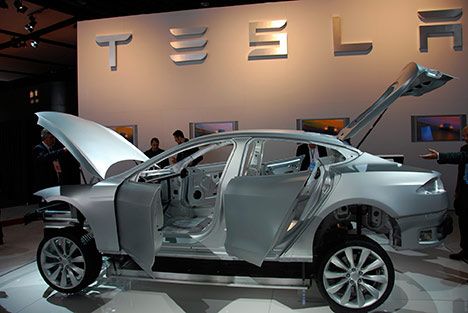It is quite interesting what
you’ll find on forums hosted by Tesla Motors. Innovation is the DNA of the
company which compels it to place value on experimentation and improvement. In
a similar forum where the discussions took a turn on cutting down the weight of
a car and thus reduce the expenditure of energy from the batteries, the use of
aluminium was heavily stressed upon. Its weight is much lesser than steel and can
carry a lot more stress. Initially, aluminium was mostly used in making the
high end cars like the Audi A8. BMW, Mercedes-Benz, Porsche, Land Rover, Jaguar
all followed suit after learning the versatility of the metal. But of late, its
applications have found way into mass market models like the Ford F150 truck.
Audi can afford to include the best of all the worlds in a single car and mark
its price up at high premium. But Ford’s insight and courage to make a near 100%
aluminium F150 model, a mass market model which has persistently been the
highest selling vehicle in the US, is really commendable.
What did they achieve? For
starters, the weight of the newer model was 315 kg lesser than the preceding
model, allowing it to brag about much better fuel efficiency (a 29%
improvement) and drastically lower carbon emissions. The load carrying capacity
was also increased with enhanced acceleration and braking response than the
previous model. In a comparative analysis between aluminium and steel conducted
by the University Of Buenos Aires School Of Engineering, it showed 8.2% less
energy consumption in favour of aluminium during the entire vehicle life cycle,
as well as 10.3% lower CO2 emission. Would it only be fair if the model won
some award for this feat? Well, the truck's been given the highest reliability
rating by National Highway Traffic Safety Administration (NHTSA) in the US, 5 stars
instead of the 4 stars that the previous model was given.
Coming back to Tesla, it uses 3
layers of protection in its cars.
- Level 1 - a special shaped aluminium beam that can toss away any object the car bumps into and/or absorb the shock
- Level 2 - a titanium plate that protects the most vulnerable components in the front of the vehicle
- Level 3 - a stamped aluminium shield that dissipates the energy of the shock and lifts the car over solid immobile obstacles
 This combination can literally
crush concrete and let the driver manoeuvre the vehicle even when there are
steel obstacles on the road. The reason why an aluminium body is superior in safety to a
steel one is because when aluminium parts get bent or
deformed, the deformation remains localised to the areas of impact while the
rest of the body retains the original shape, ensuring safety for the passenger
compartment. Tesla’s Model S has an entirely aluminium body which gives it a
superior range than a steel made body.
This combination can literally
crush concrete and let the driver manoeuvre the vehicle even when there are
steel obstacles on the road. The reason why an aluminium body is superior in safety to a
steel one is because when aluminium parts get bent or
deformed, the deformation remains localised to the areas of impact while the
rest of the body retains the original shape, ensuring safety for the passenger
compartment. Tesla’s Model S has an entirely aluminium body which gives it a
superior range than a steel made body.
So, why not use aluminium bodies
in all the cars? It is corrosion resistant, light weight, recyclable and thus
environment friendly. The current problem lies in the technology and expertise
of the assembly line in the automobile manufacturing units. Aluminium is a
fickle metal to bend on the assembly line, and its quirky metallurgy could mean
that body shops will have a tough time replacing bashed-in sheet metal. It’s
more expensive than steel in a raw state, in its conversion to a usable sheet
metal, and in its assembly—resulting in a 60 to 80 percent cost premium,
according to a MIT study. A recent
calculation by Forbes estimated the added cost at $500 per Ford F-150 model. But as the trend changes, so will the technology.
But let’s not get easily
distracted from the proposition of using aluminium for mass production as yet. Novelis
projects the use of aluminium in the automotive market will grow by
approximately 30% each year through the end of the decade. As a result, there have been millions of dollars of investment by
the aluminium producers in the past few years to capture the anticipated demand.
Also, many automakers are currently negotiating with aluminium
producers to build closed-loop production facilities where new aluminium car
parts are made from recycled aluminium parts taken out of discarded vehicles.
It's hard to imagine a more environmentally friendly production model than this.
The Ford F150 has truly become a cynosure of innovation and modernity for many
automakers which are soon to follow in its path. It is high time Indian manufacturers looked in this direction and pack a punch in the Indian market as well, boosting the Make in India campaign.



Ceramic Protection is one of the leading paint protection company in Brisbane.We have a well trained and qualified applicator. We provide premium car paint
ReplyDeleteprotect rust protection and rust proofing services in Brisbane. Ceramic Protection – World Renowned Quality Applicators!We use tested and proven products with years of punishment all over Australia. From our premium limited-edition
Ceramic paint protection to our tint & rust proofing services. We have the knowledge and skill to provide our
customers with the results they deserve. it provides the best preparation and techniques coupled with the best industry-leading products.